Time isn’t your friend in Math Rush
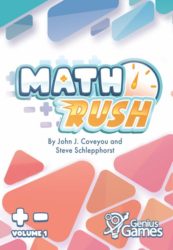
How good are you at math?
Will it make a difference if you’re calculating over and over with a timer ticking away?
In Math Rush by Genius Games, you and your fellow players race against time to cooperatively play your cards to accomplish various goals.
It may sound simple, but when the timer’s ticking away, you’ll quickly find there’s more to think about during the game than just addition and subtraction.
We know because the challenge of this simple-sounding game caught us by surprise.
How well will your family do?
How to play Math Rush
Math Rush is a timed cooperative card game played over 3 rounds. Players work together to accomplish as many Goals as they can during each round to score points.
To begin each round, players are dealt a hand of Number cards depending on the number of players. For example, in a 4-player game, each player gets 3 cards and in a 2-player game, each player gets 5 cards.
The catch is that the Number cards don’t just show a number. Instead, they show equations of either Addition or Subtraction. Players will have to do the calculation in their head to figure out what value each card represents.
The Goal cards are also shuffled and 3 are placed face up in a column. Each Goal card shows 4 things:
- The number of cards required to reach the Goal
- The direction of card values (ascending or descending)
- The points players will get for accomplishing the Goal successfully
- Any special requirements
Players set a timer for 3 minutes (not included) and they’re ready to go!
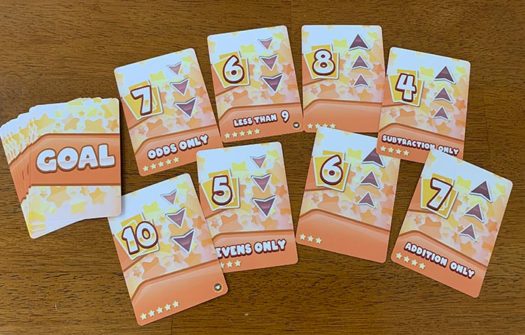
Rather than taking turns, players play cards from their hands at any time.
To play a card, players place it to the right of a Goal card and to the right of any card already played in that growing row. The order the cards are played to the right of Goal cards is important.
Each subsequent card must continue to meet the conditions of the Goal card in its row.
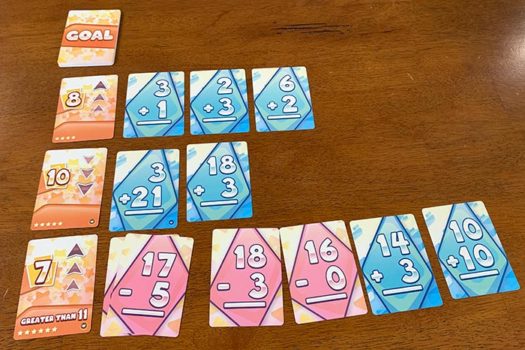
For example, if a Goal card shows Ascending, the next card played must be higher than the previous card. Once played in a location, a card may not be moved. (Thus, you can’t play to the left of cards already on the table.)
However, Number cards may also be played on top of already-played number cards of equal value. For example, a 6+3 card may be played on top of a 10-1 card.
As they play cards, they also draw up to their hand size and keep going.
During a round, players may also play a Help card. Playing a Help card allows players to remove any quantity of Number cards from a row or to discard any quantity of cards from their hand and redraw. Unused Help cards grant points at the end of the game.
Once a row has a quantity of cards equal to the number printed on the Goal card, the Goal card is flipped face-down and another Goal card is drawn and put into play. This makes it so there are always 3 Goal cards in play.
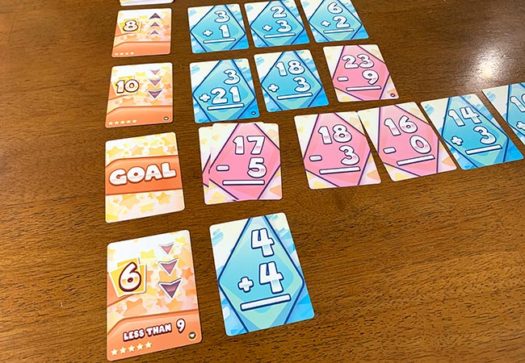
Once the 3-minute timer ends, players stop playing cards and check the Goals they’ve completed.
If they’ve successfully met the conditions of the Goal card, they score the number of points listed on the Goal card. If they made a mistake in completing a Goal, they don’t receive any points for it.
Then players shuffle all the cards into their respective decks and play another round.
After 3 rounds, players total their score and see how well they did.
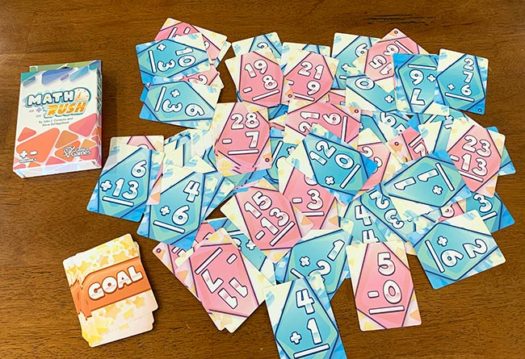
Can the whole family enjoy Math Rush?
Math Rush is a great game to play with the whole family.
When we first heard about Math Rush, we thought it sounded too simple for our grown kids. After all, it’s just simple addition and subtraction, right?
So I asked a co-worker with young kids to give it a shot and let me know what his family thought.
And they had a great time!
So much so that days later his wife was looking to buy a copy of Math Rush for their family.
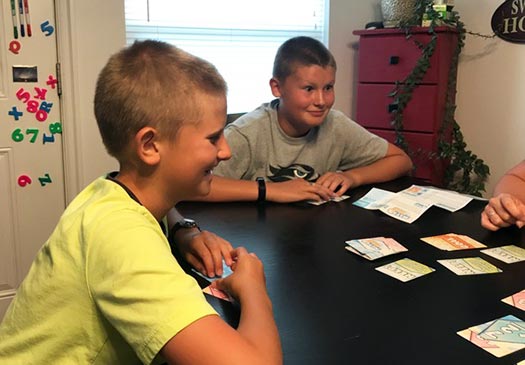
In particular, they loved the cooperative nature of the game, the card design, and the subtle answer key on the back of the cards.
We’ve reviewed a bunch of cooperative board games and card games for a reason — because family games are awesome when you’re all on the same team!
And Math Rush fits in nicely with its cooperative gameplay.
You can play with each player holding their cards or placing them face-up on the table. In either case, you’re going to have to do a lot of communicating to play well.
Since you’re racing to place cards in the right order to accomplish Goals, you’ll be shouting numbers to each other the whole time.
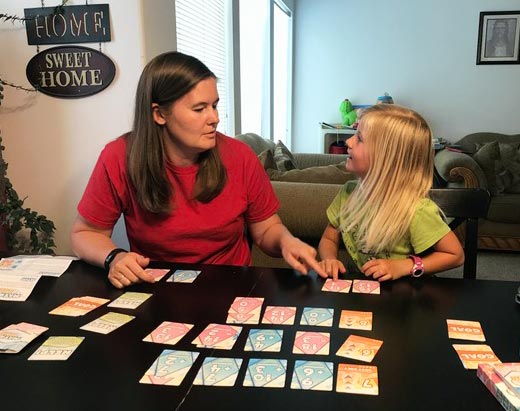
The card design is also super helpful. The numbers on the cards are a great size. Plus, the Addition cards are blue and the Subtraction cards are pink. When you’re rushing, that’s a great visual reminder of what you’re calculating.
And at the end of the round, when you’re trying to determine if you’re correct in completing Goals, there’s an easy way to verify if you got cards in the right order. On the back of each card is a letter in the corner. For ascending Goals, the letters should be in alphabetical order and in reverse for descending Goals. Pretty cool.
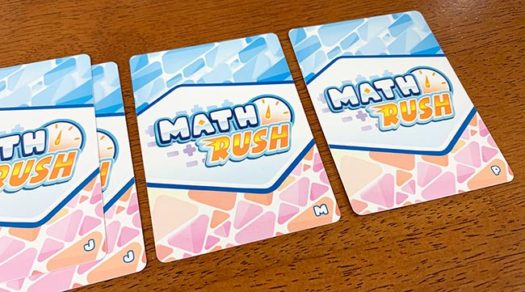
But unlike our original thoughts, Math Rush isn’t just a challenge for young kids!
After my co-worker played with his family, we gave the game a shot ourselves. And we were pleasantly surprised at how challenging it was for teens and adults as well.
Sure the equations in and of themselves are straightforward. However, when you have a hand of 4 cards and you’re up against the timer, we found ourselves constantly recalculating the values of the cards in our hands to know when and where to play them.
That’s because the variety of Goals keep us on our toes the whole time. Just when we think we’ve got a good card to play next in a row, we realize there’s an additional condition of “Odds only” or “Subtraction only” so we can’t play our card there after all.
That may still sound simple, but when you’re racing against a timer, the pressure’s on!
And that’s why we can easily recommend Math Rush for a game the whole family can play together.
How does Math Rush score on our “Let’s Play Again” game meter?
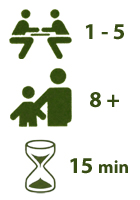 Even though we’ve enjoyed playing Math Rush with grown kids, the sweet spot for the game is for families with younger kids — and especially those learning addition and subtraction. We can see such families getting a lot of repeat plays of Math Rush.
Even though we’ve enjoyed playing Math Rush with grown kids, the sweet spot for the game is for families with younger kids — and especially those learning addition and subtraction. We can see such families getting a lot of repeat plays of Math Rush.
And like many cooperative games, Math Rush can also be played solo!
So if you can’t gather friends and family to play with you, you can test your own high scores. Which means it can also be a great learning tool for young kids. Math Rush is a lot more fun than doing math flashcards.
And check out other fun family games from Genius Games!
We’d like to thank Genius Games for a review copy of Math Rush.



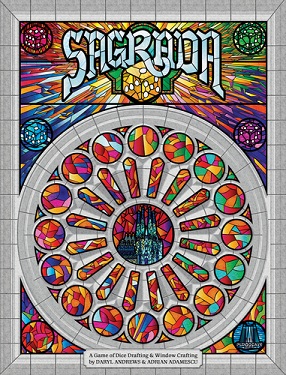
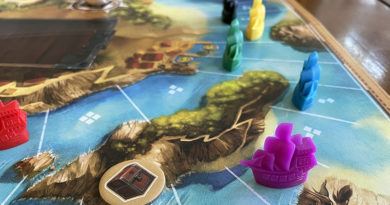
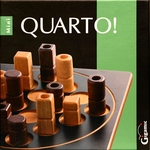
Very well prepared and explained .. I loved the tutorial .. I’m dying to buy the game!